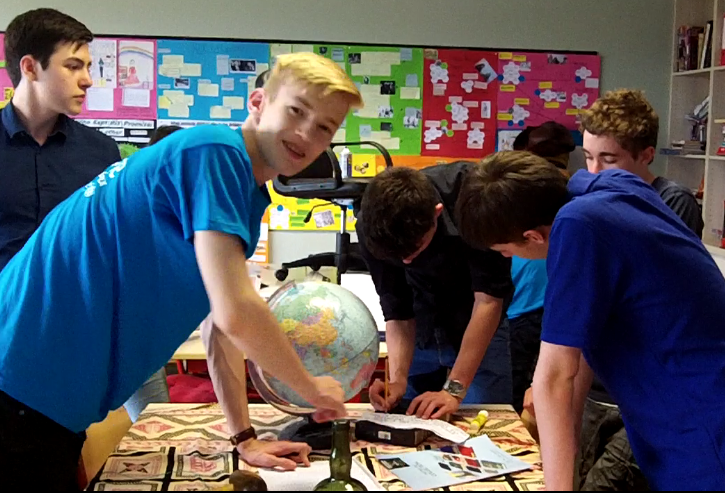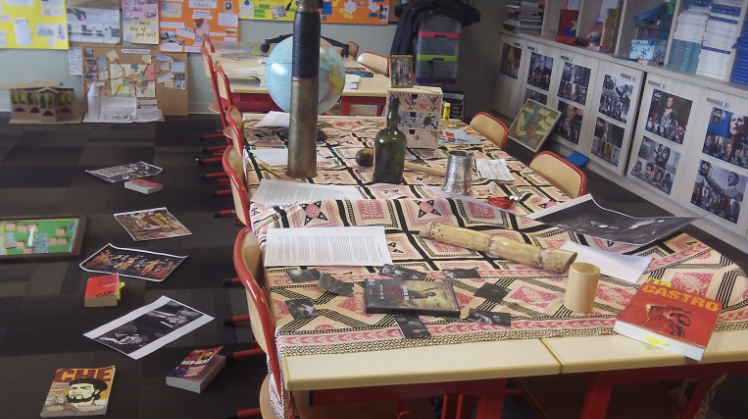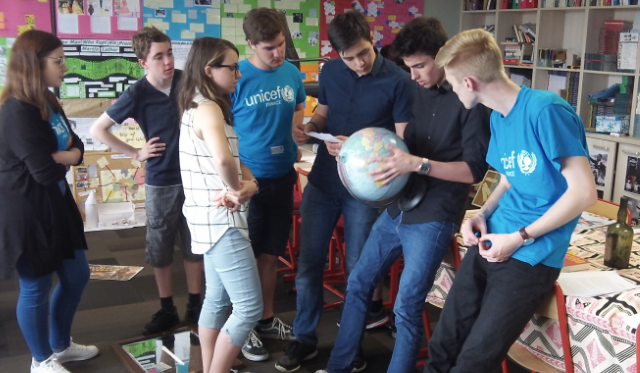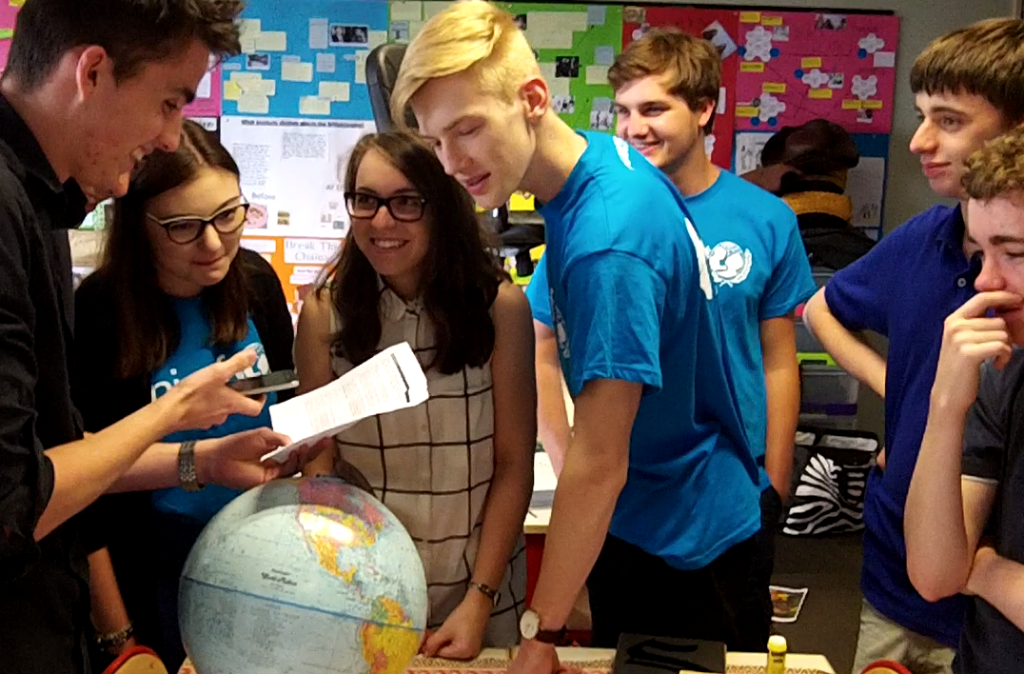A. Overview
For an introduction to the Escape Room format and how it can be used in the classroom, please consult this earlier blogpost.
This post is designed to be read alongside its partner post: “Educational Escape Rooms: Case Study 1 – larger groups / younger students“
Escape Room case study: smaller groups / older students

- Students enter the classroom which has been rearranged with lots of objects, source extracts, images and clues (many of which are red herrings).
- Firstly, the scenario is outlined, explaining why they need to escape from the room:
- Example: “You are American business people from the United Fruit Company, placed under house arrest by the new Castro regime due to your close ties to Batista. You have managed to get the guard with rum and he has passed out. But you have only one hour to find a way to escape before he wakes up and takes his revenge”.
- The basic rules are then outlined:
- Areas within the room that are out bounds are labelled with “No entry” signs.
- All other areas can be explored fully and you are encouraged to do so.
- Your factual knowledge is likely to be tested at key points. Ignorance will be a setback.
- You can only use phones to make a voice call (if required as part of the simulation).
- It pays to work as a team, with specific people given specific tasks / locations to investigate.
- Students are then given 5 minutes to explore the room however they wish and start checking out the various writings, images and other objects. This is a great way to get them engaged with some interesting sources.
Main Activity: the missions
- The teacher then presents the students with a cryptic clue about where to locate the instructions for the first mission.
- Students have to find the mission, which will be written on a piece of paper and will involve obtaining relevant historical knowledge.
- Once they think they have the correct answer (in whatever form this takes) they tell the teacher what they think it is.
- If the answer is incorrect, the teacher tells them so and refuses to accept another suggested answer for two minutes.
- If the answer is correct, the teacher elaborates with a little more detail about the subject to reinforce its historical importance, then proceeds to provide a cryptic clue about the location of the second mission.
- This format is repeated for the remainder of the missions.
- Students need to complete all the missions before they successfully ‘escape’ from the room (e.g. by locating a key, or another teacher comes to rescue them after a phone call).
B. Case Study: “Cuba 1959 – Escape to Freedom”
Setting up the Escape Room
On the last lesson of the previous week, my IB History students made some initial notes on the rise of Fidel Castro from their textbooks and a video documentary over the weekend as part of our ongoing studies about the rise and rule of authoritarian regimes.
Over the weekend, I prepared a series of missions, each of which consisted of several discrete parts:
- A cryptic clue hinting at where the instructions for the mission could be found
- The mission itself, which would be printed off on paper and then hidden in the appropriate spot. Completing this would need students to demonstrate or acquire historical knowledge in some unusual way.
- Some follow-up information relating to the mission to provide students with additional historical information.
This phase of the process was the most challenging, because it involved coming up with lots of ideas about where the mission slips could be hidden, how I could provide a clue to find them, what these missions would then involve, and what historical knowledge would be acquired as a result.
On the Monday lunchtime, before their lesson, I locked my classroom and set to work creating the ‘escape room’ environment.
- First, I spread books, articles, website extracts and images relating to the Rise of Castro all over the room and on the walls. These provide the raw historical information that will enable students to answer the questions which form the basis of each “mission”.
- Among these I added various ‘dummy’ props such as a chair on a table, a box of paperclips, a combination lock, a tablecloth spread over one of the desks, some particularly nice coffee table books and anything else I had pilfered from my shelves or neighbouring classrooms.
- The next step was to hide the instructions for each mission in various predetermined places around the room hinted at in the cryptic clue associated with each one.
- At this point, and after making sure some Cuban music was playing in the background, the lesson was ready to start!
The Lesson
- I started the lesson by locking my classroom and standing in the corridor outside it. When the students arrived I asked them to make their way inside, at which point they quickly worked out that they couldn’t get in until I opened it up – although peering through the room they could see that something strange was lined up!
- I then outlined the scenario: “You are American business people from the United Fruit Company, placed under house arrest by the new Castro regime due to your close ties to Batista. You have managed to ply the guard with rum and he has passed out. But you have only one hour to find a way to escape before he wakes up and takes his revenge”.
- Next, I proceeded to outline the essential rules:
- Areas within the room that are out bounds are labelled with “no entry” signs.
- All other areas can be explored fully and you are encouraged to do so.
- Your factual knowledge is likely to be tested at key points. Ignorance will be a setback.
- You can only use phones to make a voice call (*required by this particular simulation, as will become clear).
- It pays to work as a team, with specific people given specific tasks / locations to investigate.
- Students were then given 5 minutes to explore the room however they wished and started checking out the various writings, images and other objects. This was a great way of getting them engaged with some interesting sources – and it was interesting to note that they were very keen to scrutinize these even without knowing what they were looking for or trying to learn by doing so.
The First Mission
At the end of the five minutes of exploration, I gave the students their first mission (“Mission Red”). This consisted simply of a list of 10 factual questions that they needed to answer. Crucially, only the answer to the first one needed to be stated to the teacher to obtain the clue to the location of the next mission. However, I made it clear that the answers to all of the others, plus any other information they learned from me during the exercise, would be crucial to complete the last mission and secure their final escape. This was a very effective idea for the first mission, because it meant that several members of the class could then focus on getting answers to these various questions, whilst the rest of the team tackled the next mission. All these factual questions could all be answered using their existing knowledge or by using the images, books and primary sources within the room.
The Remaining Missions
The remaining missions followed a standard basic format:
- “Step 1: Find your mission” – the teacher presents the students with a cryptic clue about where to locate the instructions for the next mission. Each of these missions should be given a distinct name (“Mission Red”, “Mission Green” etc). This means that if students inadvertently find another mission instruction as they root around the room, they cannot shortcut to it (although they can keep it to one side until that mission becomes ‘live’).
- “Step 2: Complete the mission” – upon finding the mission slip, the team reads out the instruction. This will involve obtaining relevant historical knowledge. Once they think they have the correct answer (in whatever form this takes) they tell the teacher what they think it is. If the answer is incorrect, the teacher tells them so and refuses to accept another suggested answer for two minutes.
- “Step 3: Stop the clock: information rush” – If the answer is correct, the teacher stops the clock and elaborates with a little more detail about the subject to reinforce its historical importance. Students should take notes.
The teacher then returns to Step 1 to move students on to the next mission.
A few sample missions:
The crucial thing is of course to actually come up with some creative ideas about where to hide the mission slips, what the cryptic clue should be to help students find them, what those missions should entail, and what follow-up information can be given to students at each stage. Here are some examples of the first few missions I put together to give you some ideas about how you could structure the activity (Note: the full list of missions and supporting materials can be downloaded from this page of ActiveHistory).
| “LOCATE YOUR MISSION: Alex von Tunzelmann will give you your next mission”
( – mission written on a slip and placed in the middle of Tunzlemann’s “Red Heat”). |
“MISSION BLACK: Who, according to Tunzelmann in her very last reference to Batista, thought that by cutting military aid to him, the US helped precipitate the Cuban Revolution?” (NOTE: full name, not just surname, needed) | Arthur Schlesinger | • Answer to obtain from a textbook / articles in the room – e.g. with a reference requiring them to make use of the index. | Arthur Schlesinger is an interesting witness but it must be borne in mind that he was a Kennedy loyalist and so naturally inclined to criticise Eisenhower in contrast. |
| “LOCATE YOUR MISSION: The situation of your next mission is a little explosive”
( – mission hidden in a decommissioned grenade) |
“MISSION BLUE: Subtract 8 years from Castro’s age at the time he seized power in Cuba. Use this number to crack the following quote.
V MZQJGPODJI DN V ADBCO OJ OCZ YZVOC WZORZZI OCZ APOPMZ VIY OCZ KVNO. |
A Revolution is a struggle to the death between the present and the past. | • Encode a quote using a substitution cipher. Students have to decode it using the cipher wheel. | Castro’s youth, idealism and dynamism contrasted favourably with Batista and his mafia friends such as Meyer Lansky. |
| “LOCATE YOUR MISSION: You will have to look upwards to obtain your next mission”.
( – mission sellotaped on the underside of a table) |
“MISSION GREEN: The code will become clear once you have dove tailed the nine pieces” | An image of Castro addressing crowds upon seizing power is chopped into 9 pieces and these are hidden in places around the room. When reconstructed, the image can be turned over to reveal a completed statement with one word per square: “The code is: Unemployment was 17% by late 1958”. | • Divide up a picture source and hide it around the room. When reconstructed a message / code is revealed. | The image is iconic because doves landed on Castro as he spoke, which for the deeply religious Cubans was a sign of divine favour. The high rate of unemployment was a major cause of Batista’s growing unpopularity. |
Ideas for other missions
The remaining missions for this particular “Escape Room” follow in a similar format. Some missions are hidden on the underside of tables, other under plant pots, another is written in an invisible Ultraviolet pen which can only be seen using a UV torch (without batteries – these too have to be located). The sorts of tasks included identifying a white substance lying suspiciously on the floor, converting a latitude longitude co-ordinates to identify key places, getting a message from a CD even though there was no means of playing it anywhere in the room, putting names to three key figures whose role in the revolution is outlined, and finally completing the missing digits of a phone number to call the CIA operative to ‘spring’ them from the room (but only after they successfully pass security clearance by giving a three word code based on answers to specifically numbered questions in the first mission).
C. Reflections
What went well: The format of the activity is very easily adaptable to other topics, year groups and curriculum subjects. The students really enjoyed the lesson and got a lot out of it – not just in terms of historical knowledge (which was my crucial test of whether the activity was worthwhile) but also in terms of skills – some historical (e.g. using an index effectively, skim reading, interpreting images) and others more social (dividing the tasks between the team, thinking laterally). There was a real sense of urgency and excitement about the lesson and a genuine desire to complete the missions by acquiring the knowledge to answer the questions. The removal of the internet from the equation forced them to rely on their own resources (“Now I know how people used to feel without Google!” said one student as he leafed through one of the many sources). Completing the final mission – which involved dialling a mystery number to get through to their rescuer – worked really well. The arrival of the “CIA Operative” in”Men in Black” style wearing wraparound shades and announcing that their helicopter was waiting to fly them back to Florida in safety was a great moment (thanks, Richard!).
What to improve / bear in mind next time: Before the activity, I thought the cryptic clues I gave, and the mission instructions, were sufficiently challenging without being too difficult. In reality, the students were often very flummoxed – although when given a hint their usual reaction was “Of course!”. Therefore, whilst I will not make any of the missions any easier, I will be prepared to give hints when they clearly get to the point that they are stuck. For example, one clue was “Your next mission will require you to look upwards” – for the next few minutes they were all craning their necks trying to see the clue on the ceiling. So I then added “Hint: looking upwards does not mean necessarily that the mission is located above eye level” – at which point they quickly worked out that it was likely to be hidden underneath a table. Determining the moment to give a hint requires a bit of judgement from the teacher but it’s important to keep the game moving without making it too easy.
Conclusion: The “Escape Room” format makes for a fantastic lesson experience. It takes a lot of initial preparation, but now that this particular lesson is resourced it will be very simple to run it again next year. My next objective is to arrange one “Escape Room” activity for each of my other year groups – which will stretch my imagination in terms of a sufficient number of varied activities but should be an enjoyable and worthwhile challenge.
D. Links
Russel Tarr, Design educational “escape rooms” for your students! | Tarr’s Toolbox (Available at: http://www.classtools.net/blog/educational-escape-rooms-as-a-lesson-format/)
Russel Tarr, The Rise and Rule of Fidel Castro – ActiveHistory (Available at: https://www.activehistory.co.uk/Miscellaneous/menus/IB/castro/index.php)


